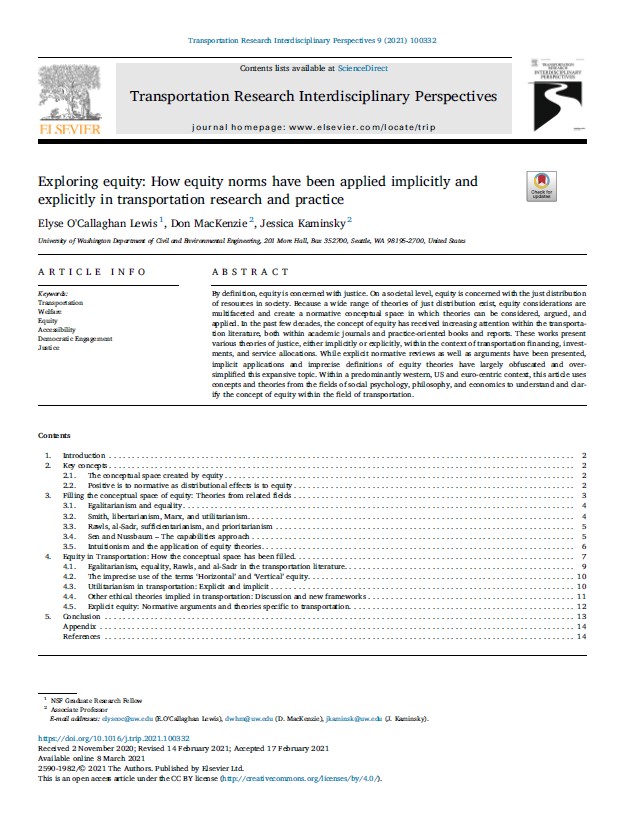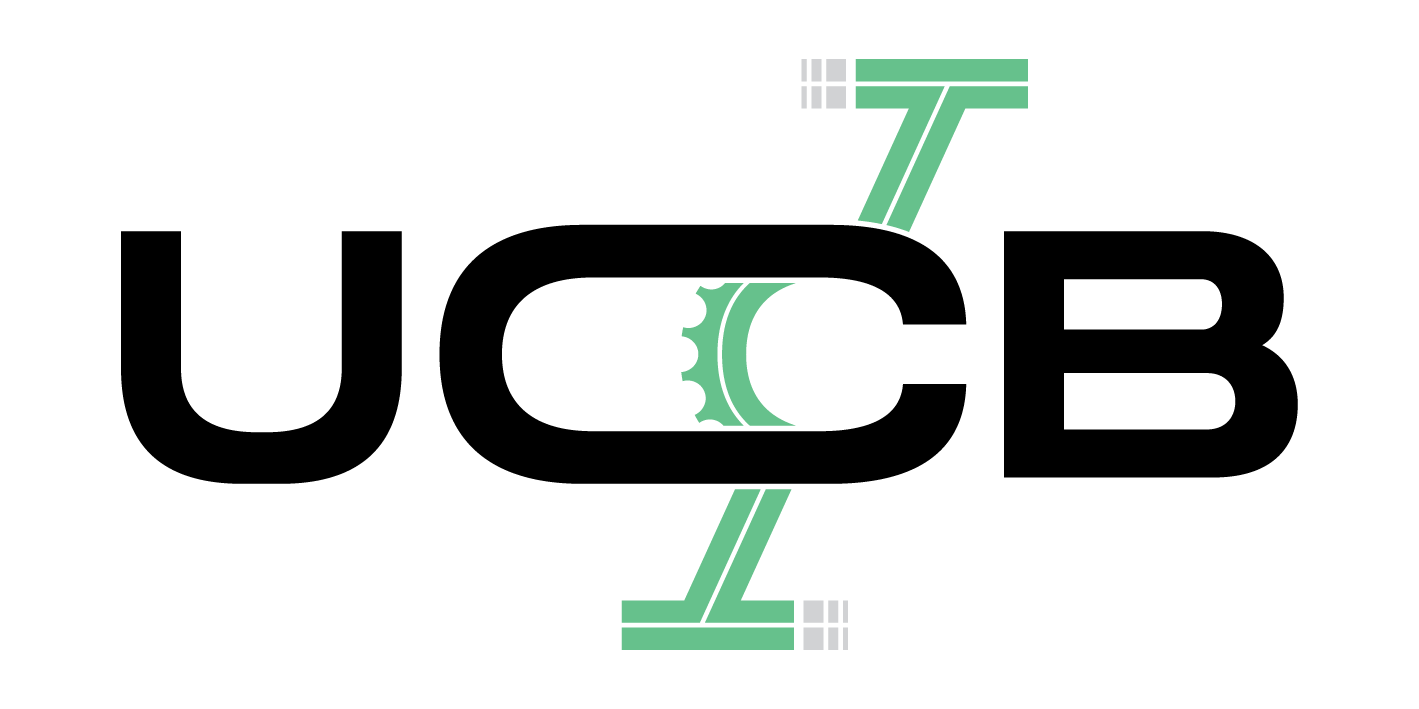Exploring equity: How equity norms have been applied implicitly and explicitly in transportation research and practice
Tipo de publicação
Artigo
Curso ou área do conhecimento
Transporte
Veículo
ELSEVIER
Tipo de autoria
Pessoa Física
Nome do autor
Elyse O'Callaghan Lewis, Don MacKenzie, Jessica Kaminsky
Língua
Inglês
Abrangência geográfica
Internacional/Mundial
Ano da publicação
2021
Palavra chave 1
Equidade
Palavra chave 2
Planejamento Urbano
Palavra chave 3
política de transporte
Palavra chave 4
Políticas Públicas
Descrição
1. Introduction
Interest in equity within the transportation profession has exploded
in the past few decades. While the delivery of equitable transportation
systems has been presented as an ideal by many, few have managed to
articulate what equity is, let alone how to functionally achieve it
within a transportation setting. This conceptual confusion stems from
the fact that equity is a wide‐reaching concept rooted in the study of
ethics and morality. In the introductory article of a special issue on
Equity in Transport, Di Ciommo and Shiftan (2017) note that moral
debate “is inevitable–although mostly invisible–in transport project
appraisal” (p. 148). In other words, ethics have always been at play
in transportation, but the explicit consideration of ethics through the
lens of equity has only become mainstream within the past few decades.
Moreover, it is difficult to engage in a moral debate when you
do not realize there is a debate to be had, i.e. when morals in transportation
remain “mostly invisible”. Even with the realization that
there is a debate to be had, it is difficult to engage effectively in that
debate without an understanding of relevant concepts.
Accordingly, the primary goal of this paper is to provide transportation
researchers and practitioners a broad, common base of understanding
of the concept of equity, particularly the different types of
theories that fall under the umbrella term of equity. Section 2 introduces
key concepts for the paper such as how the concepts of equity,
justice, and fairness relate to one another. Additionally, the distinction
between positive and normative analyses within the field of economics
– and how it parallels the difference between distributional effects and
equity analyses – is discussed. Section 3 presents fundamental theories
of equity and the key distinctions among them. The theories presented
in this section are informed by – and support the analysis of – the
transportation literature found in Section 4. Because the literature considered
was largely generated by US‐ and Euro‐centric authors, the
theories presented in Section 3 are from predominantly western European
thinkers.
It is important to note that each of the theories presented in Section
3 is the subject of entire bodies of literature spanning centuries
of thought and debate. Readers familiar with the study of philosophy
or welfare economics will likely command a deeper understanding of
many (if not all) of these theories than what is presented in this article.
The goal of Section 3 is not to capture the full depth and breadth of
these theories; the goal is to present a brief explanation of core theoretical
tenets and underlying assumptions to highlight differences
and similarities between them.
Section 4 builds on the concepts and theories presented in Sections
2 and 3 to explore the often piecemeal and occasionally contradictory
ways in which various theories of equity have been presented and
used, both explicitly and implicitly, within the transportation literature.
The goal of this section is to alleviate conceptual confusion by
highlighting differences and contradictions in order to clarify them.
It is not a comprehensive review of transportation equity literature
but rather a sample of existing resources available to anyone seeking
equity definitions within the transportation literature. Primary sources
(journal articles) as well as derivative works (reports and books) are
included in this analysis to capture the range of resources considered
by academics as well as practitioners. Section 5 concludes the article
with recommendations for best practices.
2. Key concepts
This section introduces concepts fundamental to understanding
how equity has been discussed and operationalized, both implicitly
and explicitly, in transportation. Section 2.1 explains why equity is
such a difficult concept to define concisely, let alone operationalize,
and Section 2.2 provides clarifying terminology and associated concepts.
The goal of this section is to provide readers with precise definitions
of terms that are used throughout the remainder of the paper.
2.1. The conceptual space created by equity
While the word equity can be used with regard to monetary valuations
of property, the primary dictionary definition states that equity is
“justice according to natural law or right specifically: freedom from
bias or favoritism” (“Equity | Definition of Equity by Merriam‐
Webster,” 2019).
Modern transportation discussions surrounding equity mostly
evoke this primary, justice‐oriented definition. While this singlesentence
definition may appear simple and straightforward, to understand
(let alone operationalize) the concept of equity, one must first
understand the concept of justice. The book Perspectives on Social Justice:
From Hume to Walzer consider the contributions of primary western
philosophers. They discuss Pareto’s assessment that, because
different individuals can hold different value systems and therefore
competing claims of justice, this “essential contestability … renders
[the concept of justice] meaningless” (Boucher and Kelly, 1998, p.
78). In response, Boucher and Kelly (1998) explain that:
“At the highest level of abstraction, the definition of justice is
uncontroversial: i.e. giving each person his due, in conformity with
proper principles and procedures. Exactly what these principles and
procedures should be is open to conflicting interpretations, however.
‘Empty’ rather than ‘meaningless’ would seem to be a more
accurate way of describing the concept. Given that nature abhors
a vacuum, it would be futile to expect people to refrain from ‘filling’
this emptiness with their subjective feelings and values
(‘intuitions’)” (pp. 78–79)
By extension, equity can be viewed as an empty concept that must
be filled. Put another way, when authors use the term ‘equity’, they
generate a conceptual, normative space. Authors then fill this space
either explicitly with clearly defined arguments or implicitly with
whatever idea of justice intuitively comes to mind. Equity within the
field of transportation has essentially created a normative space that
many positively‐trained researchers and practitioners rushed to fill,
often implicitly.
2.2. Positive is to normative as distributional effects is to equity
The distinction between positive and normative analyses was first
proposed by Robbins (1984) relative to the study of economics.
Robbins (1984) distinguishes between assessments of the world as it
is (positive) vs. the world as it ought to be (normative). Positive analyses
provide powerful, consistent methods to understand the world
around us; once a positive analysis is framed and the logic is established,
the execution of that logic requires computation, not thought
(Chu‐Carroll, 2013, pt. IV). Proponents of positive economic analytical
methods cheekily refer to this as “Mindless Economics” and argue that
only positive economic analyses produce results that are objective
enough to be called Economics (Caplin and Schotter, 2008, pt. I). They
argue that these fixed, axiomatic interactions analyzing individual’s
revealed preferences of demand through monetary valuations represent
objective, irrefutable, neutral truth. For example, Pareto’s opinion
of justice as a “meaningless” concept follows a positive line of reasoning
(Boucher and Kelly, 1998, p. 78).
However, as proponents of “mindful” (normative) economics point
out, both normative and positive, non‐economic fields of inquiry add
value and are necessary to frame positive analyses with intention
(Caplin and Schotter, 2008, pt. II). Beyond problem framing, normative
understandings help determine what is to be done with the knowledge
produced by positive methods. As Robbins states, “[t]here is
nothing in [positive] economics which relieves us of the obligation
to choose” (Robbins, 1984, p. 152). This relationship is presented in
Fig. 2.1.



 Ao navegar no Observatório da Bicicleta você concorda com os
Ao navegar no Observatório da Bicicleta você concorda com os